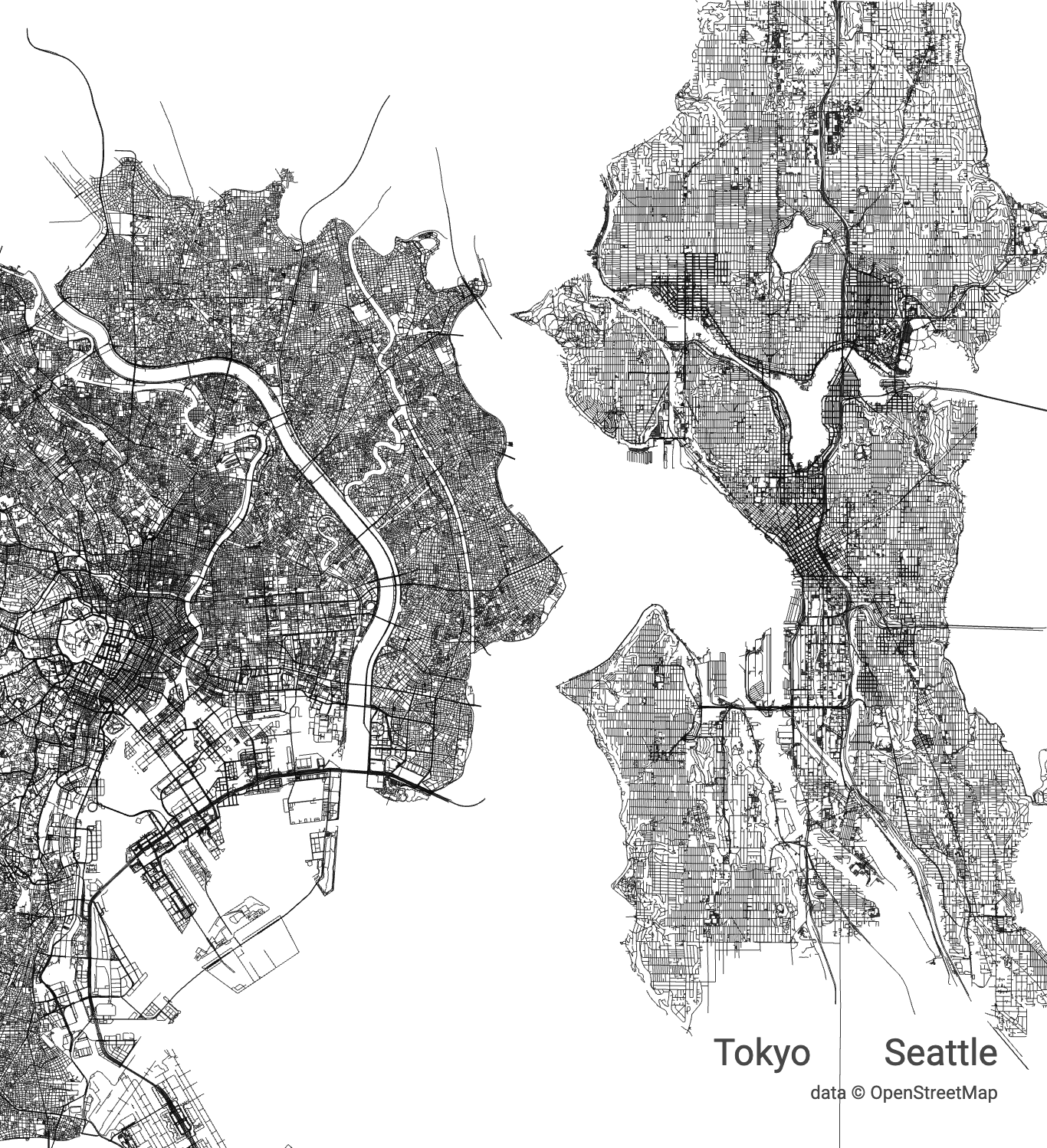4.7 KiB
Console API
This is work in progress and subject to change. Please don't rely on it for anything critical
The city-roads provides additional set of operations for the software engineers, allowing them
to execute arbitrary OpenStreetMap queries and visualize results.
Methods
This section describes available console API methods.
scene.load()
Allows you to load more city roads into the current scene. Before we dive into details, let's explore what it takes to render Tokyo and Seattle next to each other.
First, open city roads
and load Seattle roads. Then open developer console and run the following command:
scene.load(Query.Road, 'Tokyo'); // load every single road in Tokyo
Monitor your Networks tab and see when request is done. Tokyo bounding box is very large,
so it will appear very far away on the top left corner. Let's move Tokyo grid next to Seattle:
// Find the loaded layer with Tokyo:
tokyo = scene.queryLayer('Tokyo');
// Exact offset numbers can be found by experimenting
tokyo.moveBy(/* xOffset = */ 718000, /* yOffset = */ 745000)
scene.load() has the following signature:
function load(wayFilter: String, loadOptions: LoadOptions);
wayFilteris used to filter out OpenStreetMap ways. You can find a list of well-known filters here. If you need to know more to create custom filters, here is a complete language guide. You can also get good insight into key/value distribution for ways by exploring taginfo (make sure to sort by Ways in descending order to get the most popular combinations);loadOptionsallows you to have granular control over the bounding box of the loaded results. If this value is a string, then it is converted to a geocoded area id with nominatim, and then the first match is used as a bounding box. This may not be enough sometimes, so you can provide a specific area id, or a bounding box, by passing an object. For example:
scene.load(Query.Road, {areaId: 3600237385}); // Explicitly set area id to Seattle
scene.load(Query.Building, { // Load all buildings...
bbox: [ // ...in the given bounding box
"-15.8477", /* south lat */
"-47.9841", /* west lon */
"-15.7330", /* north lat */
"-47.7970" /* east lon */
]});
scene.queryLayerAll()
Returns all layers added to the scene. This is what it takes to assign different colors to each layer:
allLayers = scene.queryLayerAll()
allLayers[0].color = 'deepskyblue'; // color can be a name.
allLayers[1].color = 'rgb(255, 12, 43)'; // or a any other expression (rgb, hex, hsl, etc.)
scene.clear()
Clears the current scene, allowing you to start from scratch.
scene.saveToPNG(fileName: string)
To save the current scene as a PNG file run
scene.saveToPNG('hello'); // hello.png is saved
scene.saveToSVG(fileName: string, options?: Object)
This command allows you to save the scene as an SVG file.
scene.saveToSVG('hello'); // hello.svg is saved
If you are planning to use a pen-plotter or a laser cutter, you can also
greatly reduce the print time, by removing very short paths from the final
export. To do so, pass minLength option:
scene.saveToSVG('hello', {minLength: 2});
// All paths with length shorter than 2px are removed from the final SVG.
Examples
Here are a few example of working with the API.
Loading all bikeways in the current city
var bikes = scene.load('way[highway="cycleway"]', {layer: scene.queryLayer()})
// Make lines 4 pixels wide
bikes.lineWidth = 4
// and red
bikes.color = 'red'
Loading all bus routes in the current city
This script will get all bus routes in the current city, and render them 4px wide, with red color:
var areaId = scene.queryLayer().getQueryBounds().areaId;
var bus = scene.load('', {
layer: scene.queryLayer(),
raw: `[out:json][timeout:250];
area(${areaId});(._; )->.area;
(nwr[route=bus](area.area););
out body;>;out skel qt;`
});
bus.color='red';
bus.lineWidth = 4;
If you want a specific bus number, pass additional ref=bus_number. For example, bus route #24:
var areaId = scene.queryLayer().getQueryBounds().areaId;
var bus = scene.load('', {
layer: scene.queryLayer(),
raw: `[out:json][timeout:250];
area(${areaId});(._; )->.area;
(nwr[route=bus][ref=24](area.area););
out body;>;out skel qt;`
});
bus.color = 'green';
bus.lineWidth = 4;
